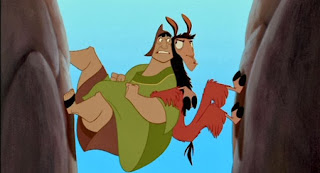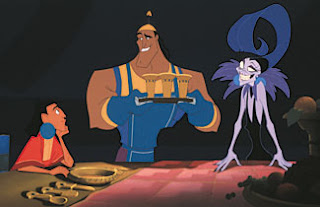I know you’re all impatient to get to talking about Day of the Doctor, or at least I am, but
I need a little bit longer to cook my opinion, so in the meantime, let’s talk
about one of my absolute favorite animated films, and also one of the weirdest
things I’ve ever seen.
You guessed it (from the title), we’re talking about The Emperor’s New Groove.
One of the lesser known Disney films, The Emperor’s New Groove came out in 2000, just as Disney was
starting to slide into mediocrity again at the tail end of its “Renaissance”.
Starring David Spade as the voice of Kuzco, an Incan emperor in pre-colonial
South America, the story is weird, original, and surprisingly progressive for
Disney. Which was borne out when the film was released to solid numbers, but
bad ones for Disney. The company made a couple of direct-to-video sequals, then
pretty much just let this thing rot.
Which is a real shame, because digging in a little deeper,
the film has a couple of things very few other Disney films, or kids films at
all, can claim: actually good life lessons.
Also it’s hilarious.
I figure you know what I’m talking about. When you start to
think at all critically about children’s films you begin to realize that most
of the morals here are either neutral in their morality or actually downright
harmful, the kind of thing you wouldn’t want any child to learn, no matter how
annoying he is.
I’m talking about how Beauty
and the Beast condones domestic violence, and how The Little Mermaid is about changing yourself to be more attractive
(and also stalking), and how Sleeping
Beauty and Snow White both
glorify date rape, and Pocohontas is
blearily racist, and so is Peter Pan,
and so on and so on and so on.
Really, when you come down to it, there aren’t very many
kids’ movies that don’t have a disastrous moral lesson attached.
Except for this one. Which is pretty funny. The movie, which
was originally conceived as a more standard Disney flick based around Hans Christian
Anderson’s story “The Emperor’s New Clothes”, eventually ended up as both a
surrealist exploration of South America, and as one of the few childrens’
movies with a decent ending.
Like I said above, the movie is about Kuzco, an Incan
emperor, who rules absolutely and loves every single second of it. Having been
considered a divine leader since his birth, Kuzco has a sense of entitlement
big enough to choke a man. He has no sense of proportion or humility. His
people adore him because they have to, and Kuzco sees nothing wrong with that.
So when he wants to build a new summer palace, the emperor sees nothing wrong
with picking a spot already occupied: a sweet little mountaintop village,
inhabited by the gentle farmer Pacha (John Goodman) and his family.
Unfortunately for Kuzco, his chief advisor, Yzma (Eartha
Kitt), kind of sort of hates his guts with the fire of a thousand suns, and is
plotting to kill him. But she can’t just kill him kill him, mostly because that
isn’t diabolical enough for her. She’s not the most complex of villains.
Eventually, Yzma decides to just poison Kuzco. That way
he’ll die and she can rule the empire. But since her assistant, Kronk (Patrick
Warburton), was chosen for his studly good looks rather than his mental
capacities, it all goes wrong and instead of ending up dead, Kuzco ends up a
llama. And then instead of ending up drowned, Kuzco winds up in a sack on the
back of Pacha’s cart, headed out of the city.
Hijinks ensue.
Or rather, Yzma decides that if Kuzco isn’t really dead then
they have to go after him and finish the job. But Kuzco, who wakes up a llama
and is very displeased, has made a deal with Pacha to help him get back to the
palace. If Pacha gets him there in one piece, then he’ll agree to build his
summer palace somewhere else. Yay!
What commences is a race to the finish line, full of weird
adventures, emotional growth, and lots of jokes that only adults will get.
Kuzco tries to go back on his word about every five minutes, while Pacha deeply
questions his life choices and why he is so honorable as to save the life of a
man (llama) who is perfectly happy ruining his. Yzma and Kronk are hilarious
and diabolical – well, Yzma is diabolical while Kronk is mostly good-natured
and lovable – and the whole story flows with a sort of zingy, madcap feel.
Which is to say that it’s very good and I like it. But the
ending is what I like best.
By the end of the film, our heroes have finally made their
way back to the palace, only to find Kronk and Yzma waiting for them with the
proper potion to turn Kuzco human again. There’s a scuffle, some attempts at
magic, and finally a decision. Pacha hangs from the edge of a ledge, dangling
and about to fall to his death. The vial that contains the all important potion
hangs off of another ledge. Kuzco can’t reach both. What does he do?
Well, this is a Disney movie, so he saves Pacha, and then
together they get the other potion. All good and standard, right? Kuzco learns
his lesson and builds his summer palace somewhere else, Yzma gets turned into a
cat, and Kronk gets to go off and live a life of peace and quiet and teaching
small children how to talk to squirrels.
Have I mentioned that Kronk is my favorite character?
Because Kronk is my favorite character. In pretty much everything. We’ll get to
that more in a bit.
So Kuzco learns his lesson, that his problems aren’t
actually the center of the world, and everyone gets a nice happy ending. And
that’s good, don’t get me wrong. That does in fact happen. But it’s a little
bit more subversive than that. You see, the ending, where we actually get to
see that Kuzco has learned his lesson shows us that in addition to learning
that Pacha’s livelihood has value and that he shouldn’t be so selfish, Kuzco
actually comes to repudiate his status as emperor. Not insofar as he actually
gives up the throne, but enough that instead of building a summer palace (near
Pacha’s house, instead of on top of it), Kuzco builds a little hut.
Okay, I get that this seems really tiny and insignificant,
but it’s not. It says something a lot deeper than, well, pretty much everything
else.
It means that Kuzco didn’t just learn humility, he also
decided that some of the trappings of his office were actually unfair. He
didn’t inherently deserve more than Pacha did. And so, he decided to be Pacha’s
equal. That is big, guys. Bigger than big. That’s huge.
I mean, we talk a lot about the real hidden messages in
movies on here, but I think this is one of the cooler ones. Kuzco comes out of
his ordeal with a new perspective on life, and it’s one that is shockingly
anti-wealth. Which is great. The
Emperor’s New Groove is a story about a spoiled young boy who learns
humility, respect for others, and that material goods only matter insofar as
you let them.
Which is awesome, and also probably explains why Disney is
so happy to forget about this movie. Because how the hell do you merchandise
that?
One last thing before I go. Kronk. Let’s talk about Kronk.
Or, more specifically, let’s talk about how Kronk, despite being kind of sort
of the bad guy, is actually the most moral person in the entire film. I just, I
just love him. I love how he’s super sensitive and sweet, how he looks like he
should be Yzma’s henchman and muscle, and he’s clearly supposed to be, but
Kronk is much happier making spinach puffs and hosting dinner parties and
making friends with the wildlife. Basically, I love Kronk because instead of
the normal henchman role, we got a huggy, sweet, happy man-child who just wants
to do the right thing. And that’s fabulous. Also surprisingly progressive. So
yay on all fronts.
The movie even passes the Bechdel Test. And all of the characters
are non-white. And it takes place in pre-colonial South America. It’s weird and
weird and weird and hilarious and I love it.
Okay. I’ll stop talking about this now.
Maybe.
Go watch it.







"And all of the characters are non-white."
ReplyDeleteHa ha, yes, one of them is purple! :)
We had a teacher at Ecola who sounded just like Kronk, it was da best.
And what a lovely shade of lavender it is. :DDD
Delete